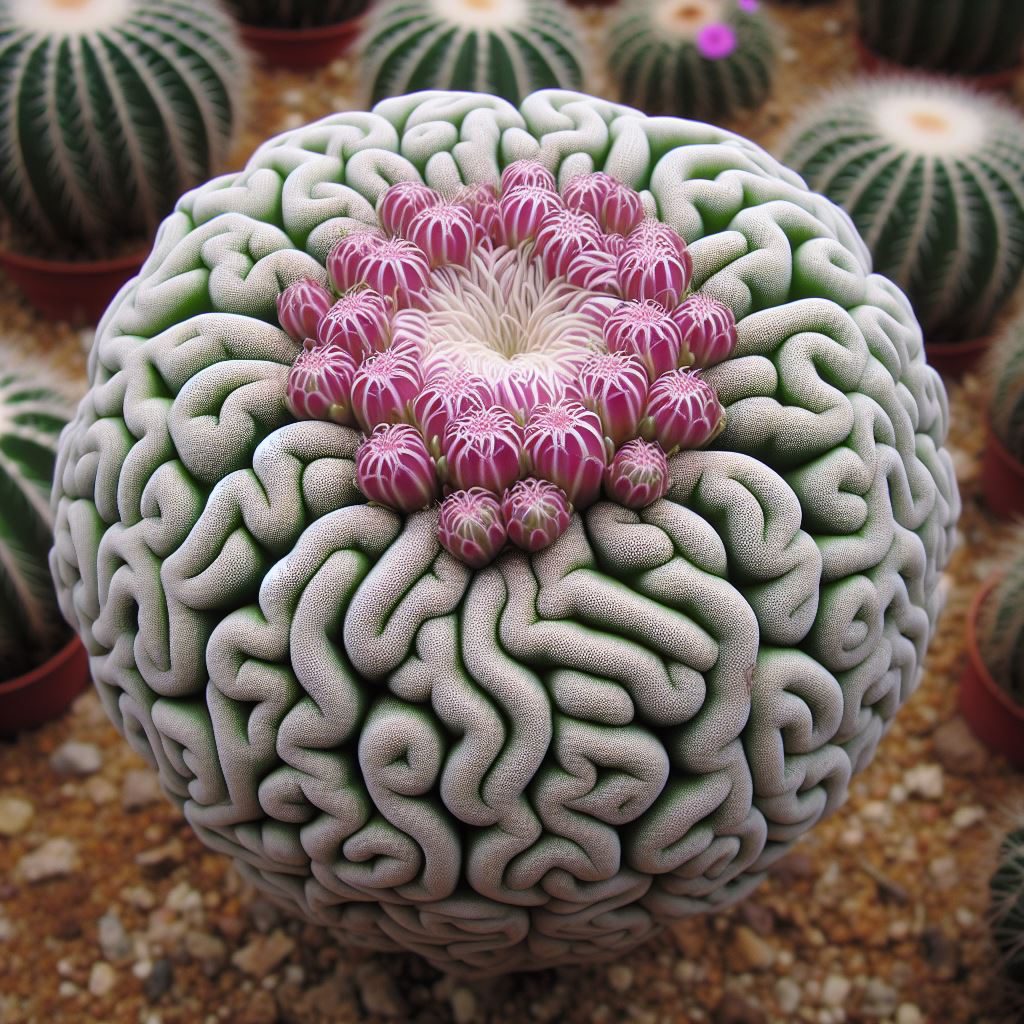
The Brain Cactus, an intriguing succulent, is bound to captivate onlookers. True to its nomenclature, this cactus astonishingly mirrors the appearance of a human brain. It remains relatively modest in size, seldom exceeding a few inches in height and width. Adorned in a rich green hue, the Brain Cactus boasts a smooth, matte surface.
Originating from the dry regions of Mexico, the Brain Cactus, despite its peculiar visage, proves to be an undemanding plant. It flourishes in luminous, indirect light and thrives in soil with excellent drainage.
Overwatering is its Achilles’ heel; thus, infrequent hydration is advisable. The Brain Cactus may blossom with meticulous care, revealing petite, alabaster flowers.
Non-toxic to both humans and pets, handling this cactus still warrants caution due to its spines, which can provoke irritation.
Propagation of the Brain Cactus can be achieved through seeds or offsets.
Scatter the seeds on a well-draining cactus blend for seed propagation, maintaining moisture until germination. Once seedlings emerge, they can be transplanted into individual containers.
For offset propagation, gently detach an offset from the parent cactus, allowing it to be callous for several days before planting it in a well-draining cactus mixture.
Although the Brain Cactus is predominantly low-maintenance, growers might encounter a few prevalent issues. Overwatering stands out as a common dilemma, often leading to root rot.
Overhydration is likely the culprit if your Brain Cactus begins to soften or discolor. Allow the soil to desiccate thoroughly before the next watering session.
Another frequent concern is sunburn. The Brain Cactus thrives in bright, indirect sunlight but can suffer from sunburn if exposed to direct sunlight for prolonged periods. Indications of sunburn include the yellowing or browning of the cactus’s epidermis. If sunburn is detected, reposition the cactus to a locale with more indirect light.
FAQ
With the right knowledge, caring for a Brain Cactus, with its unique, brain-like appearance, can be easy. Here are answers to some of the most frequently asked questions about this intriguing succulent:
Watering
How often should I water my Brain Cactus?
Brain Cactus prefers infrequent watering, allowing the soil to dry completely between sessions. Overwatering is a major threat, so err on the side of underwatering.
Light
Can Brain Cactus survive in low-light conditions?
While Brain Cactus can tolerate some shade, it thrives in bright, indirect sunlight. Low light can hinder growth and flowering.
Soil
What is the best soil mix for Brain Cactus?
A well-draining cactus mix is essential. Look for mixes specifically formulated for cacti and succulents, ensuring it drain quickly to prevent root rot.
Pests and Diseases
How do I deal with pests on my Brain Cactus?
Brain Cactus is relatively pest-resistant, but mealybugs can be an occasional issue. Isolate the plant and treat with insecticidal soap or neem oil.
Outdoor Living
Can Brain Cactus be grown outdoors?
Yes, Brain Cactus can thrive outdoors in warm climates with adequate drainage. However, protect it from excessive rain and harsh sunlight, especially during midday.
Pet and Child Safety
Is Brain Cactus safe around pets and children?
While not toxic, Brain Cactus has small spines that can irritate skin and eyes. It’s best to keep it out of reach of curious pets and young children.
Additional Questions
How fast does Brain Cactus grow?
Brain Cactus is a slow grower, typically adding only a few inches per year. Be patient and enjoy its gradual development.
Does Brain Cactus flower?
Yes, mature Brain Cactus can produce small, white flowers in spring or summer under optimal conditions.
How do I propagate Brain Cactus?
Propagation is possible through offsets or stem cuttings. Ensure proper care and patience for successful results.
By understanding these key points, you can provide your Brain Cactus with the perfect environment to thrive and continue to marvel at its unique, brain-like form.
Conclusion
The Brain Cactus is more than just a plant; it’s a testament to nature’s ability to surprise and fascinate us. Whether you’re a seasoned gardener or a curious newcomer, the Brain Cactus offers a unique opportunity to engage with the natural world in a deeply personal way.
Its care is simple, its appearance unparalleled, and its presence in any collection or garden is sure to spark conversation and wonder. Embrace the peculiar beauty of the Brain Cactus and discover the joy it can bring to your gardening journey.
In our exploration of “What Is Brain Cactus,” we’ve uncovered the essence of this extraordinary succulent. From its curious growth pattern to its ease of care, the Brain Cactus stands as a symbol of the wonders of the plant kingdom. It serves as a reminder that beauty can be found in the most unexpected forms, inviting us to look closer and appreciate the intricacies of the natural world.






















